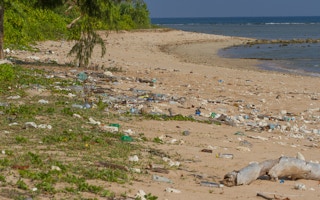A microplastic is a tiny speck of a thing. At its largest, it’s about the size of a linseed, but smaller microplastics can’t be seen with the naked eye. Minuscule as they are, huge quantities of these particles are gushing into the ocean, and they’re almost certainly causing damage to delicate marine ecosystems, experts say.
A new report published in Science reveals the roving trajectory of microplastics after they enter the ocean. While some microplastics, like flecks of polystyrene, may float on the surface, most microplastics accrue algae and minerals that cause them to sink to the seafloor. From there, microplastics are picked up by deep-sea currents, which deposit them in areas of high sediment, creating what the study’s authors call “microplastic hotspots.”
A team of international researchers collected data for this study by taking sediment samples from the seafloor in the Tyrrhenian Sea in the Mediterranean. They found that microplastic accumulated at depths of 600 to 900 meters (about 2,000 to 3,000 feet), and that microplastic hotspots can hold up to 1.9 million pieces per square meter, which is the highest level ever to be recorded on the seafloor, according to Ian Kane, the study’s lead author.
“We were shocked by the sheer number of [microplastics],” Kane told Mongabay. “1.9 million is enormous. Previous studies have documented much smaller numbers, and … just talked about plastic fragments, but it’s fibers that are really the more insidious of the microplastics. These are the things that are more readily consumed and absorbed into organisms’ flesh.”
A “microplastic” is generally defined as a particle smaller than 5 millimeters, or about a fifth of an inch. Some microplastics are deliberately manufactured, like microbeads found in cosmetics, while others form when sunlight breaks down “macroplastics,” such as plastic water bottles and food containers. However, the majority of microplastics are textile fibers from things like polyester clothing, Kane said.
“Most of it is coming out of wastewater treatment from both domestic and industrial sources, and being carried through the sewage system,” Kane said. “The problem at the moment is that the filters on most wastewater treatment plants don’t filter out microplastics, so they’re entering river systems and then they’re being flushed out into the sea.”
The problem with microplastics is that they attract and accumulate toxins that make them dangerous to any organism that consumes or absorbs them.
“They act as focal points for the accumulation or precipitation of toxins on their surface … in particular, things like hydrocarbons,” Kane said. “And they last a long time. They don’t break down quickly so they can accumulate these toxins, they can be consumed by organisms, and they can persist even after that organism dies. So they’re very long-lived nucleation points for the toxins and nasty things.”
The bottom currents that push microplastics around on the seafloor are also responsible for moving oxygen and nutrients, which suggests that plastic is ending up in biodiversity hotspots in the ocean, where it can cause the most damage.
“The effects of microplastics in the deep sea ecosystem are really poorly understood,” Kane said. “[Microplastics] are available to be consumed, and they can also be absorbed into the flesh of soft-bodied creatures. So they’re entering the food web at the lowest levels, and by the time you get to the bigger creatures in the trophic web, then they have the opportunity to consume a lot of microplastic.”
While more research needs to be done on the subject, this report fills some critical gaps in plastic pollution research: it shows how large quantities of microplastics can travel to the seafloor, and be carried into critical marine habitats.
“Our study has shown how detailed studies of seafloor currents can help us to connect microplastic transport pathways in the deep-sea and find the ‘missing’ microplastics,” Mike Clare, a co-author of the study, said in a statement. “The results highlight the need for policy interventions to limit the future flow of plastics into natural environments and minimise impacts on ocean ecosystems.”
This story was published with permission from Mongabay.com.










